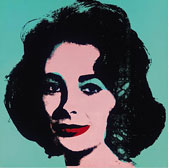

 Warhol's Liz 'Ohhhh, Elizabeth Taylor, ohhhh, she's so glamorous.' Andy Warhol's Liz pays tribute to a larger-than-life superstar whose international fame as a glamazon of the silver screen had brought her the level of celebrity the artist himself so coveted and admired. Painted at the pinnacle of Elizabeth Taylor's fame, Liz is a unique variation from a group of thirteen colourful portraits of the actress produced in the fall of 1963. Rarely viewed in public, the present Liz is an outstanding example of Warhol's genius for colour and is closely related to his Marilyn 'flavours' paintings executed in the previous year - which were named after their vibrant candy colours. Despite mimicking mass media production techniques through screen-printed imagery, Warhol brought a high level of personal involvement to the Liz series. Each work has been created with individually coloured backgrounds, hand-painted skin, eyes and make-up. Produced in the 40 by 40 inch format that would become Warhol's preferred layout for portraits, Liz not only incorporates a magnificent jewel-like turquoise ground, offset against luminous lavender skin, but also includes Taylor's trademark scarlet lips and violet eyes, reproducing the most characteristic features of her celebrated beauty. As one of the most desired women in Hollywood in the 1960s, Taylor encompasses all the glitter and controversy of stardom that Warhol found endlessly attractive. Almost her entire life has been led in the full glare of the media and her inescapable presence provided Warhol with the ideal subject-matter for his paintings. Not only fabulously beautiful and famous, Taylor has also been touched by scandal and personal tragedy. In keeping with his preoccupation with death and disaster, Warhol began producing paintings of Taylor as early as 1962, following on the heels of her collapse from pneumonia on the film set of Cleopatra. Initially replicating the front page of the Daily Mail, Warhol reproduced a sequence of biographical moments from her life including, amongst others, a still from her childhood role in National Velvet and an image of her in full Cleopatra costume. Following these works, Warhol created a series of portraits on silver painted canvas. As with Marilyn Monroe, he began with the type of image through which Taylor was disseminated to the masses, modifying the found photograph by cropping under the chin before enlarging it on to a silkscreen. Warhol used this same screen for the Silver Liz paintings and the subsequent coloured Liz's, whose dazzlingly bright tones provide a distinct character to each work. Although he began to document the actress's life while her health was failing, as a form of memento mori, Warhol conceived his colourful full face portraits of Liz in a somewhat different light, remarking, 'I started those a long time ago, when she was so sick and everybody said she was going to die. Now I'm doing them all over, putting bright colours on her lips and eyes'. In this respect, Liz embodies a vivid picture of rejuvenation, which coincides with Warhol's own ascending profile as a superstar of the art world and a celebrity in his own right. The effect is a perfect imitation of Hollywood mythologizing. Conceived in the golden age of American capitalism, Warhol's Liz presents Taylor's sultry persona as a seductive consumer product, acknowledging the manufactured nature of fame and preserving the splendour of the starlet's looks as a popular and enduring icon of the modern age. Faith Chisholm is a researcher in the Post-War & Contemporary Art Department, London |